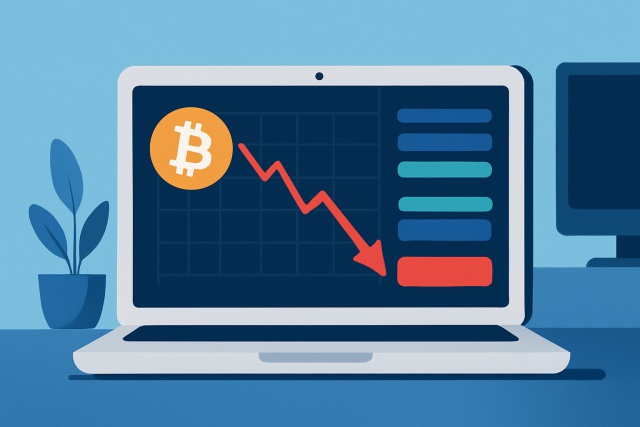Bitcoin Paper Wallet Security Explained Simply


A bitcoin paper wallet is a simple, old-school method to stash your cryptocurrency offline. Paper wallets keep your Bitcoin keys totally offline giving your funds a solid shield against hacking and malware nastiness.
So, what exactly is a Bitcoin Paper Wallet?
A bitcoin paper wallet is basically a physical printout that shows your Bitcoin public address and private key. Think of it as a little paper treasure map storing everything you need to send and receive Bitcoin, all without relying on digital storage.
Paper wallets are just one piece of the bigger bitcoin storage puzzle known as cold storage, which is all about keeping those private keys offline and far away from prying internet eyes. They provide pretty reliable protection against online attacks, though they’re not without their quirks. Physical wear and human slip-ups can trip you up.
- The public address appears both as a string and a handy QR code you use to receive bitcoins without fuss.
- The private key is a long jumble of letters and numbers with its own QR code and is needed to access and spend those bitcoins.
- QR codes make it simpler to scan keys directly into wallets and cut down on frustrating typos.
- Since the private key is kept physically it leaves no digital breadcrumbs for hackers—but that means you must keep it locked down tight and safe.

What Exactly Is a Bitcoin Paper Wallet and How Does It Work?
Creating a paper wallet starts with generating a Bitcoin key pair offline—no internet, just good old-fashioned security. Next, you either print or jot down those keys on a piece of paper and make sure you don’t lose it in the laundry. Once that’s done, you send Bitcoin to the public address. When it’s time to spend your funds, you’ll need to import or sweep the private key into a digital wallet. That wallet then takes care of broadcasting the transaction to the Bitcoin network.
Create a Bitcoin public and private key pair offline using a trusted tool on an air-gapped computer. Think of it as keeping your keys under lock and key, away from prying eyes.
Carefully print out the keys along with their QR codes on good old-fashioned paper to create your physical wallet. Yes, paper still has its charm!
Move Bitcoin from an exchange or another wallet to the printed public address to fund your paper wallet. It is like filling up a piggy bank with digital coins.
When it’s time to spend, simply import the private key into a secure wallet app by scanning the QR code or entering it manually. This gives you seamless access to your funds without breaking a sweat.
A paper wallet isn’t some sort of physical box holding Bitcoin inside. Instead, it’s more like a slip of paper carrying secret info. The Bitcoin itself exists solely on the blockchain, floating out there in cyberspace.
What Exactly Makes a Bitcoin Paper Wallet So Useful?
The main draw of a bitcoin paper wallet is its notably better security. By keeping your keys completely offline, you mostly sidestep the usual hacking and malware headaches that digital wallets often suffer from.
- Paper wallets cannot be hacked remotely because they are completely off the grid and have no internet connection which is a big plus.
- You avoid trusting digital devices or exchange platforms that might have vulnerabilities.
- Making and printing paper wallets is affordable since all you need is a printer and some offline tools.
- Keeping paper wallets safe is simple. You just store them in a physical location without relying on digital systems.
Paper wallets usually do the trick for long-term Bitcoin storage or as a backup plan when you want to keep hefty sums of cryptocurrency safe from the usual online shenanigans.
A Closer Look at the Security Risks Behind Bitcoin Paper Wallets What You Might Not Have Noticed
Paper wallets cut out many pesky online risks but come with their own physical headaches. They can get damaged, go missing or be stolen. They can also be set up the wrong way.
- Paper tends to fall apart over time and is vulnerable to hazards like water, fire or ink fading away.
- If someone takes your physical paper or you misplace it, consider the Bitcoin it guards lost forever.
- Setting up wallets on online or sketchy devices can put your private keys at risk.
- Malware or keyloggers on infected computers can quietly snatch your private keys when you create a wallet.
- Forgetting where you stashed your paper wallets or failing to label them clearly invites mistakes.
Creating paper wallets on secure offline devices that are completely cut off from any network and printing them on trusted standalone printers usually does a good job of lowering the risk. If those private keys happen to slip out during the process, anyone with their hands on that info could swoop in and snatch the linked Bitcoin before you even realize what hit you.
"A paper wallet’s security really hinges on the care taken during its creation and how well it’s physically safeguarded — even one tiny slip-up can spell permanent loss, so it’s worth handling with kid gloves."
Key Tips for Keeping Your Bitcoin Paper Wallet Safe (Because Nobody Wants a Paper Nightmare)
Whip up your paper wallet on an air-gapped computer, one that has never even sniffed an internet connection.
Print it out using a trusty offline printer to keep any sneaky network interceptions at bay.
Tuck your printed wallet away in a waterproof, fireproof safe or stash it in a secure deposit box. Choose a place that makes it tough for Mother Nature or burglars to mess with.
Steer clear of snapping photos or making digital copies of the paper wallet because less digital clutter means fewer chances of accidental leaks.
Make a few copies of the paper wallet and hide them in different secure spots. This little trick helps protect you against the unlucky event of loss or damage.
Adding a bit of extra protection like laminating your paper wallet can really help keep moisture and wear at bay. Password encryption designed specifically for offline wallets usually adds a nice bonus layer of security, too.
When it comes to spending your Bitcoin, you move the funds by importing or sweeping the private key into a trusted digital wallet. This step calls for some extra caution because even a fleeting moment of exposing your private key online can open the door for theft.

Common Misunderstandings and Myths About Bitcoin Paper Wallet Security
Let's clear the air on some of the myths and misunderstandings swirling around Bitcoin paper wallet security—because, honestly, this stuff can get pretty tangled if you are not careful. From what I have seen, many individuals jump to conclusions or get tripped up by half-truths. So, buckle up as we gently untangle these misconceptions and shine a little light on what really matters when it comes to keeping your paper wallets safe.
- Paper wallets are theft-proof since they stay offline and can’t be hacked. There’s no digital door left open for troublemakers.
- Creating and printing paper wallets online usually works well if you take basic precautions. A little care goes a long way.
- Backing up paper wallets with photos or digital copies is a solid strategy since it’s like having a spare key hidden somewhere safe.
- If you’re using a paper wallet, hardware wallets might not be on your radar but some individuals swear by both for extra peace of mind.
- Because paper wallets exist as offline physical objects they avoid hacking risk entirely since hackers can’t break into something that isn’t connected.
These misunderstandings can be risky since they often lead to careless handling that might cause losses down the road. Paper wallets are vulnerable to physical theft or damage—they are like the flimsy old notebooks of crypto. Meanwhile, creating or printing keys on internet-connected devices opens the door for your private keys to be compromised which is never a fun situation. Snapping photos or keeping digital copies might seem convenient but they bring the same vulnerabilities as any online data and defeat the purpose of cold storage. On the brighter side, hardware wallets usually offer better security thanks to their encrypted chips and intuitive design.
Other Security Options That Can Work Hand in Hand with Paper Wallets
Alongside the trusty paper wallets, hardware wallets bring solid security to the table by keeping keys locked up tight in encrypted form. They’re generally pretty user-friendly too, and designed to shrug off any physical tampering attempts like a pro. Then you’ve got multisignature wallets, which include another level of security by making sure multiple approvals are needed before a transaction can get the green light.
| Storage Method | Security Level | Ease of Use | Cost | Risk Factors |
|---|---|---|---|---|
| Paper Wallet | Moderate | Fairly easy | Very low | Beware of physical damage, loss, or accidentally exposing your keys—these sneaky risks can catch anyone off guard |
| Hardware Wallet | High | User-friendly | Moderate | Possible theft or device damage, so treat it like your digital gold vault |
| Mobile Wallet | Low to Moderate | Very straightforward | Low | Open to malware, hacking, or simply misplacing your device—small slip-ups that happen more than you would think |
| Multisig Wallet | Very high | More complex | Moderate | Can trip up even the savviest users and might slow you down when you need fast access |
| Offline USB Backup | High | Moderate | Low to moderate | Risks include hardware failure or sneaky malware during use—definitely not for the faint-hearted |
Finding the right balance between convenience and security is absolutely key. Many individuals like to use paper wallets with hardware wallets or multisignature setups to create a security onion with multiple layers. Paper wallets shine for cold storage and are great for backups or storing Bitcoin long-term—out of sight and out of mind. Hardware wallets are a more secure choice for day-to-day spending.
Closing Thoughts on the Security of Bitcoin Paper Wallets
Wrapping things up, when it comes to the security of Bitcoin paper wallets, it is a bit of a mixed bag. These wallets can offer a pretty nifty way to keep your crypto offline and out of hackers' reach, as long as you handle them with care—think of them like that fragile, priceless family photo you stash away in a safe spot. But beware, a single misstep, such as a tear, a spill, or a stray coffee stain, could turn your treasure into a frustrating headache. So, while paper wallets have their charm and are often praised for cold storage, they definitely demand a bit of mindfulness and a few safety nets to truly keep your bitcoins under lock and key. Keep them dry, keep them hidden, and maybe double up on backups—because in the end, it is about striking the right balance between convenience and caution.
Creating and keeping bitcoin paper wallets can offer robust protection if you handle them with care. The trick lies in generating your keys offline, storing them safely and treating them like fragile treasures to avoid permanent loss or theft.
Start Your Crypto Journey with Coinbase Today
Ready to enter the cryptocurrency market but unsure where to begin? Coinbase makes buying, selling, and storing digital assets simple and secure for beginners and experts alike.








